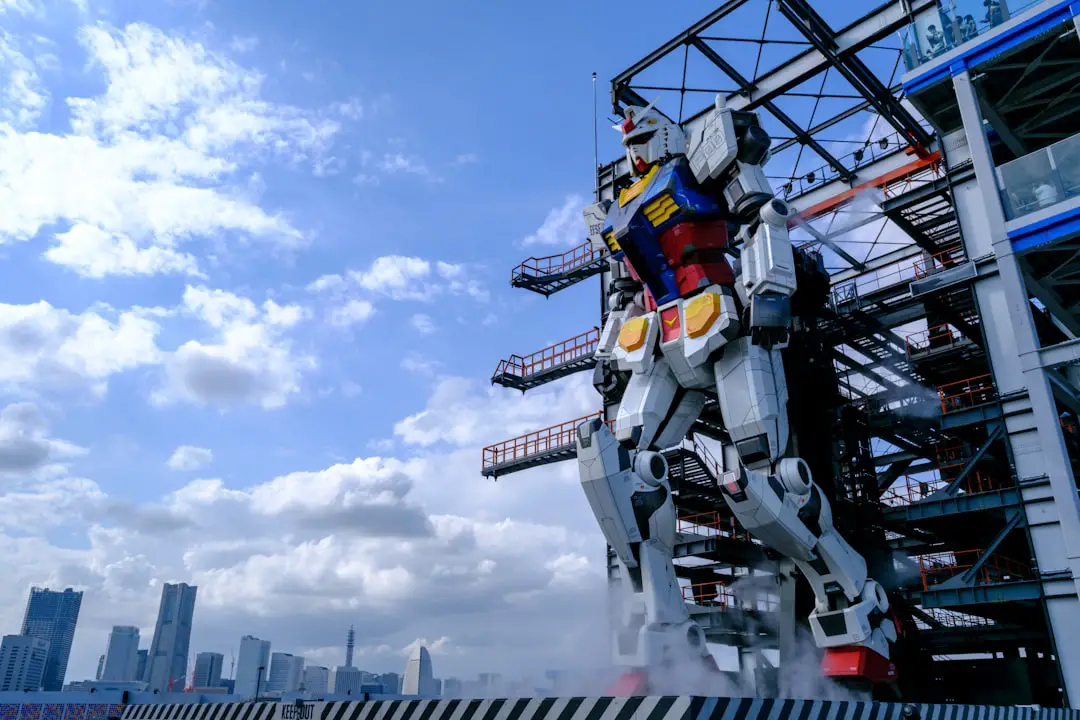Support our educational content for free when you purchase through links on our site. Learn more
What is a Smart Robot? [2024] 🤖
Have you ever wondered what makes a robot smart? 🤔 Is it their ability to perform complex tasks? Or is it their capability to interact with humans? In this article, we will explore the fascinating world of smart robots and delve into what sets them apart from their less intelligent counterparts. From their history and background to their various applications and types, we will cover it all. So, buckle up and get ready to dive into the world of smart robots! 🚀
Table of Contents
- Quick Answer
- Quick Tips and Facts
- Background: The Evolution of Smart Robots
- What Makes a Robot Smart?
- The Applications of Smart Robots
- Types of Smart Robots
- How Are Robots So Smart?
- What Is the Use of Intelligent Robots?
- Who Is the Smartest Robot in the World?
- What Are the Three Types of Robots?
- FAQ
- Conclusion
- Recommended Links
- Reference Links
Quick Answer
A smart robot is a robotic device that possesses advanced capabilities, such as perception, decision-making, and autonomous operation. These robots are equipped with sensors, processors, and software that enable them to interact with their environment and perform complex tasks without human intervention. From industrial automation to household assistance, smart robots have a wide range of applications and are revolutionizing various industries. If you’re looking to explore the world of smart robots, we’ve got you covered! Check out our recommended links for more information. 🌐
👉 CHECK PRICE on: Amazon | Walmart | Etsy
Quick Tips and Facts
Before we dive deeper into the world of smart robots, here are some quick tips and interesting facts to get you started:
✅ Smart robots are equipped with sensors, processors, and software that enable them to perceive their environment and make decisions based on that information.
✅ These robots can perform complex tasks autonomously, without the need for constant human intervention.
✅ Smart robots have a wide range of applications, including industrial automation, healthcare, education, and entertainment.
✅ Some smart robots are designed to interact with humans and provide assistance in various tasks.
✅ The field of robotics is constantly evolving, with new advancements being made in artificial intelligence, machine learning, and sensor technology.
Now that you have a basic understanding of smart robots, let’s take a closer look at their background and evolution. 📚
Background: The Evolution of Smart Robots

Robots have come a long way since their inception. From simple mechanical devices to intelligent machines, the field of robotics has witnessed significant advancements over the years. The concept of a smart robot can be traced back to the early days of robotics when researchers began exploring the idea of creating machines that could mimic human intelligence.
In the early 1950s, the term “robot” was coined by the Czech playwright Karel Čapek in his play “R.U.R.” (Rossum’s Universal Robots). However, the robots depicted in the play were more like mechanical workers and lacked the advanced capabilities we associate with smart robots today.
It wasn’t until the late 20th century that significant progress was made in the development of smart robots. With advancements in computer technology, artificial intelligence, and sensor technology, researchers were able to create robots that could perceive their environment, make decisions, and perform complex tasks autonomously.
What Makes a Robot Smart?
Smart robots are distinguished by their ability to perceive their environment, make decisions based on that information, and perform tasks autonomously. But what exactly makes a robot smart? Let’s take a closer look at the key features that set smart robots apart:
-
Perception: Smart robots are equipped with sensors that allow them to perceive their environment. These sensors can include cameras, microphones, touch sensors, and even advanced technologies like lidar and radar. By gathering data from their surroundings, smart robots can understand and interpret the world around them.
-
Decision-Making: Once a smart robot has gathered information about its environment, it needs to make decisions based on that information. This is where the intelligence of the robot comes into play. Smart robots are equipped with processors and software that enable them to analyze the data they have collected and make informed decisions.
-
Autonomous Operation: One of the defining features of smart robots is their ability to operate autonomously. Unlike traditional robots that require constant human intervention, smart robots can perform tasks without the need for direct human control. This autonomy is made possible by the advanced capabilities of smart robots, including their perception and decision-making abilities.
-
Interaction: Some smart robots are designed to interact with humans and provide assistance in various tasks. These robots can understand human speech, recognize faces, and even respond to emotions. By enabling interaction with humans, smart robots can be used in a wide range of applications, from healthcare and education to entertainment and personal assistance.
By combining these key features, smart robots are able to perform complex tasks and adapt to changing environments. Whether it’s navigating through a cluttered room or assisting with household chores, smart robots are revolutionizing the way we interact with machines.
The Applications of Smart Robots
Smart robots have a wide range of applications across various industries. Let’s explore some of the key areas where smart robots are making a significant impact:
-
Industrial Automation: Smart robots are transforming the manufacturing industry by automating repetitive and dangerous tasks. These robots can perform tasks such as assembly, welding, and material handling with precision and efficiency. By taking over these tasks, smart robots not only improve productivity but also enhance worker safety.
-
Healthcare: In the field of healthcare, smart robots are being used to assist with patient care and rehabilitation. These robots can help with tasks such as lifting patients, delivering medication, and providing companionship to the elderly. By taking on these tasks, smart robots free up healthcare professionals to focus on more critical aspects of patient care.
-
Education: Smart robots are also finding their way into the education sector. These robots can be used to teach children various subjects, including coding, math, and science. By providing interactive and engaging learning experiences, smart robots are helping to make education more accessible and enjoyable for students.
-
Entertainment: Smart robots are not just practical; they can also be a source of entertainment. From robot pets that can respond to your touch and voice to humanoid robots that can dance and perform, smart robots are bringing joy and excitement to people of all ages.
These are just a few examples of how smart robots are being used in various industries. As technology continues to advance, we can expect to see even more innovative applications of smart robots in the future.
Types of Smart Robots
Smart robots come in various shapes and sizes, each designed for specific tasks and applications. Let’s explore some of the different types of smart robots:
-
Industrial Robots: These robots are used in manufacturing and industrial settings to automate tasks such as assembly, welding, and material handling. Industrial robots are known for their precision, speed, and ability to work in hazardous environments.
-
Service Robots: Service robots are designed to assist humans in various tasks. They can be found in healthcare facilities, hotels, and even homes. Service robots can perform tasks such as cleaning, delivery, and companionship.
-
Medical Robots: Medical robots are used in the field of healthcare to assist with surgical procedures, rehabilitation, and patient care. These robots can perform tasks with precision and accuracy, reducing the risk of human error.
-
Educational Robots: Educational robots are designed to teach children various subjects, including coding, math, and science. These robots provide interactive and engaging learning experiences, making education more enjoyable and accessible.
-
Entertainment Robots: Entertainment robots are designed to provide joy and entertainment to people of all ages. From robot pets to humanoid robots that can dance and perform, these robots bring fun and excitement to our lives.
These are just a few examples of the different types of smart robots available today. Each type of robot has its own unique capabilities and applications, contributing to the diverse and rapidly growing field of robotics.
How Are Robots So Smart?
The intelligence of smart robots is made possible by a combination of advanced technologies and algorithms. Let’s take a closer look at some of the key components that make robots so smart:
-
Sensors: Smart robots are equipped with various sensors that allow them to perceive their environment. These sensors can include cameras, microphones, touch sensors, and even advanced technologies like lidar and radar. By gathering data from their surroundings, smart robots can understand and interpret the world around them.
-
Processors: Smart robots are equipped with powerful processors that enable them to analyze the data collected by their sensors. These processors can perform complex calculations and run sophisticated algorithms, allowing the robot to make informed decisions based on the information it has gathered.
-
Software: The software running on smart robots plays a crucial role in their intelligence. This software includes algorithms that enable the robot to process sensor data, make decisions, and perform tasks autonomously. Advances in artificial intelligence and machine learning have greatly contributed to the intelligence of smart robots.
-
Connectivity: Smart robots are often connected to the internet or other networks, allowing them to access vast amounts of information and communicate with other devices. This connectivity enables smart robots to learn from their experiences, update their software, and collaborate with other robots or humans.
By combining these components, smart robots are able to perceive their environment, make decisions, and perform tasks autonomously. This level of intelligence is what sets smart robots apart from their less intelligent counterparts.
What Is the Use of Intelligent Robots?
Intelligent robots have a wide range of applications across various industries. Let’s explore some of the key uses of intelligent robots:
-
Industrial Automation: Intelligent robots are revolutionizing the manufacturing industry by automating repetitive and dangerous tasks. These robots can perform tasks such as assembly, welding, and material handling with precision and efficiency. By taking over these tasks, intelligent robots improve productivity and enhance worker safety.
-
Healthcare: In the field of healthcare, intelligent robots are being used to assist with patient care and rehabilitation. These robots can help with tasks such as lifting patients, delivering medication, and providing companionship to the elderly. By taking on these tasks, intelligent robots free up healthcare professionals to focus on more critical aspects of patient care.
-
Education: Intelligent robots are also finding their way into the education sector. These robots can be used to teach children various subjects, including coding, math, and science. By providing interactive and engaging learning experiences, intelligent robots are helping to make education more accessible and enjoyable for students.
-
Entertainment: Intelligent robots are not just practical; they can also be a source of entertainment. From robot pets that can respond to your touch and voice to humanoid robots that can dance and perform, intelligent robots bring joy and excitement to people of all ages.
These are just a few examples of how intelligent robots are being used in various industries. As technology continues to advance, we can expect to see even more innovative uses of intelligent robots in the future.
Who Is the Smartest Robot in the World?
The field of robotics is constantly evolving, with new advancements being made every day. While it’s difficult to determine the smartest robot in the world, there are several robots that have gained recognition for their advanced capabilities. Here are a few examples:
-
Atlas: Developed by Boston Dynamics, Atlas is a humanoid robot known for its agility and dexterity. It can navigate challenging terrains, perform acrobatic maneuvers, and even lift heavy objects.
-
Sophia: Created by Hanson Robotics, Sophia is a humanoid robot that can interact with humans and mimic human facial expressions. It has gained attention for its realistic appearance and ability to hold conversations.
-
Pepper: Developed by SoftBank Robotics, Pepper is a social humanoid robot designed to interact with humans. It can recognize faces, respond to emotions, and provide assistance in various tasks.
While these robots are impressive in their own right, it’s important to remember that the concept of a “smart” robot is constantly evolving. As technology continues to advance, we can expect to see even more intelligent robots in the future.
What Are the Three Types of Robots?
When it comes to robots, there are generally three main types:
-
Industrial Robots: These robots are designed for industrial applications and are typically used in manufacturing and production settings. They are often large and powerful, capable of performing tasks such as assembly, welding, and material handling.
-
Service Robots: Service robots are designed to assist humans in various tasks. They can be found in healthcare facilities, hotels, and even homes. Service robots can perform tasks such as cleaning, delivery, and companionship.
-
Personal Robots: Personal robots are designed for individual use and are often found in households. These robots can perform tasks such as vacuuming, mowing the lawn, and even providing entertainment.
These three types of robots cover a wide range of applications and are designed to meet different needs. Whether it’s automating industrial processes, assisting with daily tasks, or providing entertainment, robots have become an integral part of our lives.
FAQ

How are robots so smart?
Robots are able to be smart due to their advanced capabilities, such as perception, decision-making, and autonomous operation. These capabilities are made possible by the integration of sensors, processors, and software that enable robots to interact with their environment and perform complex tasks without human intervention.
What is the use of intelligent robots?
Intelligent robots have a wide range of applications across various industries. They are used in industrial automation to improve productivity and worker safety. In healthcare, intelligent robots assist with patient care and rehabilitation. They are also used in education to provide interactive and engaging learning experiences. Additionally, intelligent robots can be a source of entertainment, bringing joy and excitement to people of all ages.
Read more about “Can Robots Be Remote Controlled? … 🤖”
Who is the smartest robot in the world?
While it’s difficult to determine the smartest robot in the world, there are several robots that have gained recognition for their advanced capabilities. Examples include Atlas, developed by Boston Dynamics, Sophia, created by Hanson Robotics, and Pepper, developed by SoftBank Robotics.
Read more about “Robots & Machines for 10 Year Olds – MindWare … 🤖”
What are the three types of robots?
The three main types of robots are industrial robots, service robots, and personal robots. Industrial robots are used in manufacturing and production settings, service robots assist humans in various tasks, and personal robots are designed for individual use in households.
Conclusion

In conclusion, smart robots are revolutionizing various industries with their advanced capabilities and autonomous operation. From industrial automation to healthcare and education, these robots are transforming the way we live and work. By combining sensors, processors, and software, smart robots are able to perceive their environment, make decisions, and perform complex tasks without human intervention. As technology continues to advance, we can expect to see even more innovative applications of smart robots in the future. So, embrace the future and get ready to witness the incredible capabilities of smart robots firsthand!
Recommended Links
- Toy Brand Guides
- Electronic Toys
- Toy Industry Trends
- Educational Toys
- Collectible Toys
- How to Make a Smart Robot at Home
Reference Links
Now that you have a comprehensive understanding of what smart robots are and their various applications, it’s time to explore the world of smart robots further. Check out our recommended links for more information and start your journey into the exciting world of smart robots today! 🤖🌐

